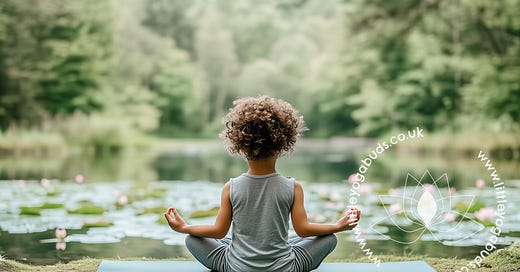Little Minds, Big Calm: Weaving Meditation into Children’s Daily Lives
Simple Ways to Help Children Discover Calm, One Breath at a Time
In today’s busy world, even our little ones can feel the rush of life. Between school, clubs, and screen time, their minds are often filled with a flurry of activity. But what if we could give them a little pocket of calm in the middle of the chaos? A space where they can pause, breathe, and just be?
Meditation isn’t just for grown-ups. It’s a powerful tool that children can easily learn, and the best part? It’s simple, free, and can be woven into their everyday routines effortlessly.
But before we dive in, let’s clear up one common question...
Mindfulness vs. Meditation – What’s the Difference?
These two words often get used interchangeably, but they’re slightly different (and knowing the difference can help you guide your child!).
Mindfulness is about paying attention to the present moment. It’s noticing the feel of the sun on your skin, the sound of birds chirping, or the taste of a juicy apple. Mindfulness encourages children to engage their senses and become aware of what’s happening around and within them.
Meditation, on the other hand, takes mindfulness a step further. It’s a focused practice where the mind slows down, and thoughts drift by like clouds. Meditation helps children develop stillness, focus, and a deeper connection to their emotions.
In short:
Mindfulness happens anytime, anywhere—while walking, eating, or even brushing teeth.
Meditation is a set time to be quiet, still, and observe thoughts and feelings.
Now that we’re clear, let’s explore how we can invite both of these practices into a child’s daily life.
Simple Ways to Weave Meditation into Everyday Life
You don’t need fancy cushions, candles, or even a quiet room. Here’s how to bring meditation into your child’s world in ways that feel natural and joyful.
1. Breathe Like a Bumblebee 🐝
Encourage your child to take slow, buzzing breaths, imagining they are a little bee. Inhale deeply through the nose, then hum softly on the exhale. This simple breath practice soothes the nervous system and brings focus.
When? Before bed, during quiet time, or when emotions run high.
2. Cloud Watching Daydreams ☁️
Lie on the grass and watch the clouds float by. Ask your child to name the shapes they see and notice how the clouds move. This gentle practice teaches non-attachment to thoughts—just like the clouds, feelings and worries come and go.
When? Lazy afternoons in the garden or park.
3. Candle Gazing (Without the Flame!) 🕯️
Ask your child to focus on an object—maybe a flower, a pebble, or even a pretend candle. Encourage them to look closely, noticing colors, shapes, and textures. This focus strengthens concentration and quiets the mind.
When? After a busy day or during storytime.
4. Teddy Bear Breathing 🧸
At bedtime, place a soft toy on your child’s belly and ask them to watch it gently rise and fall as they breathe deeply. This simple activity introduces mindful breathing and anchors their awareness to the rhythm of their breath.
When? Just before drifting off to sleep.
5. Gratitude Pebbles 🌊
At the end of the day, invite your child to hold a small stone and think of one thing they’re grateful for. As they whisper their gratitude into the pebble, they’re practicing reflection and calm.
When? As part of a bedtime wind-down routine.
Why Does Meditation Matter for Kids?
Meditation isn’t just about quiet moments—it’s about building emotional resilience and teaching children to navigate their feelings. Here’s what happens when children practice regularly:
✨ Better Focus: It strengthens their ability to concentrate in school and play.
✨ Emotional Balance: It helps them manage big feelings like frustration and anxiety.
✨ Increased Creativity: Stillness allows the mind to wander, fostering imagination.
✨ Stronger Connection: It deepens their awareness of themselves and the world.
A Few Minutes Can Make a Big Difference
You don’t need to carve out big chunks of time. Even 1-2 minutes of stillness can work wonders for young minds. The key? Make it playful, natural, and part of their day, just like brushing their teeth or putting on shoes.
And remember, children learn by watching. If they see you pausing, breathing, and embracing calm moments, they’ll be inspired to do the same.
So, whether it’s through a bumblebee breath, a teddy bear on a belly, or a gratitude pebble—each moment of stillness is a gift, gently planting seeds of calm that will grow with them for years to come.
“Peace Begins with a Breath.”
Start small. Keep it simple. And watch as little moments of calm bloom into a lifetime of inner peace.
Ready to try one today? Breathe in... and out. You’ve already begun.





